1995 PONTIAC PONTIAC air conditioning
[x] Cancel search: air conditioningPage 6 of 354

Vehicle Symbols
These are some of the symbols you may find on your vehicle.
For example,
these symbols
are used on an
original battery;
POSSIBLE A
CAUTION
INJURY
PROTECT EYES BY
SHIELDING
CAUSTIC
ACID COULD BATTERY
CAUSE
BURNS
AVOID
SPARKS
OR
FLAMES
SPARK
OR ,\I/,
COULD FLAME
EXPLODE BATTERY
These symbols
are important
for
you and
your passengers
whenever your
vehicle is
driven:
DOOR LOCK
UNLOCK
FASTEN SEAT
BELTS
S
These symbols
have to
do with
your lights:
SIGNALS e
TURN
HIGH
LAMPSoR BEAM = =o
FOG LAMPS $0
These symbols
are
011 some of
your controls:
WINDSHIELD WIPER
WINDSHIELD DEFROSTER
WINDOW
DEFOGGER
VENTILATING
a+
FAN w*
These symbols
are used
on
warning and
indicator lights:
COOLANT F-
ENGINE
TEMP
- k
CHARGING BATTERY
SYSTEM
BRAKE
(0)
RADIATOR COOLANT
a
FUEL
ENGINE OIL
PRESSURE
Wb
TEMP OIL &
ANTI-LOCK (@)
BRAKE
Here are some
other symbols
you may see:
FUSE
RELEASE RADIO
k
VOLUME a
CONDITIONING AIR 33
RELEASE TRUNK ru
t
LIGHTER m
SPEAKER
b
V
ProCarManuals.com
Page 126 of 354
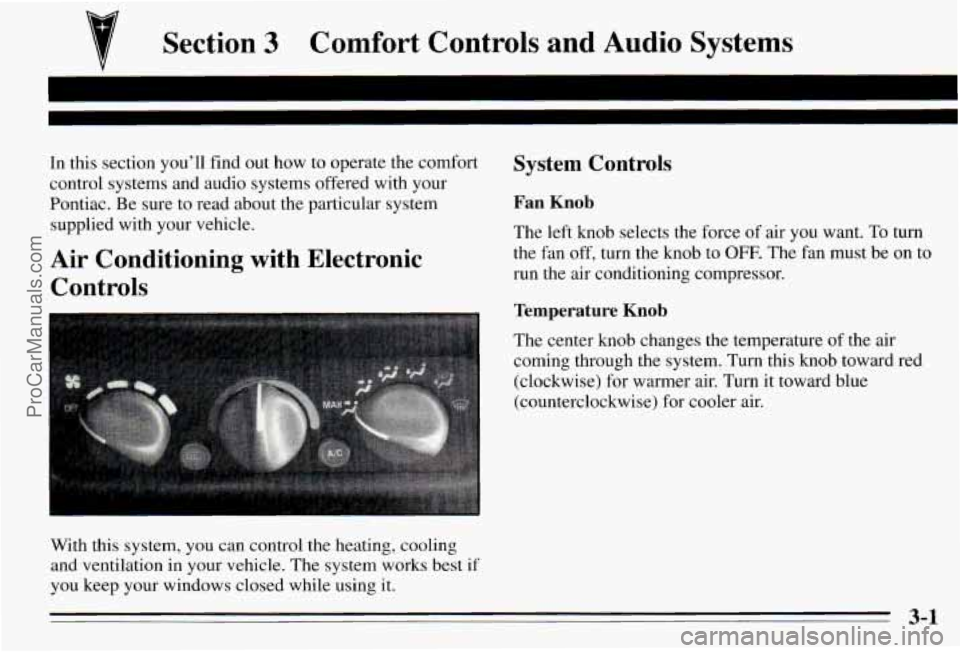
7 Section 3 Comfort Controls and Audio Systems
In this section you’ll find out how to operate the comfort
control systems and audio systems offered with your Pontiac. Be sure to read about the particular system
supplied with your vehicle.
Air Conditioning with Electronic Controls
With this system, you can control the heating, cooling
and ventilation in your vehicle. The system works best if
you keep your windows closed while using it.
System Controls
Fan Knob
The left knob selects the force of air you want. To turn
the fan off, turn the knob to OFF. The fan must be on to
run the air conditioning compressor.
Temperature Knor,
The center knob changes the temperature of the air
coming through the system. Turn this knob toward red
(clockwise) for warmer air. Turn it toward blue
(counterclockwise) for cooler air.
3-1
ProCarManuals.com
Page 127 of 354
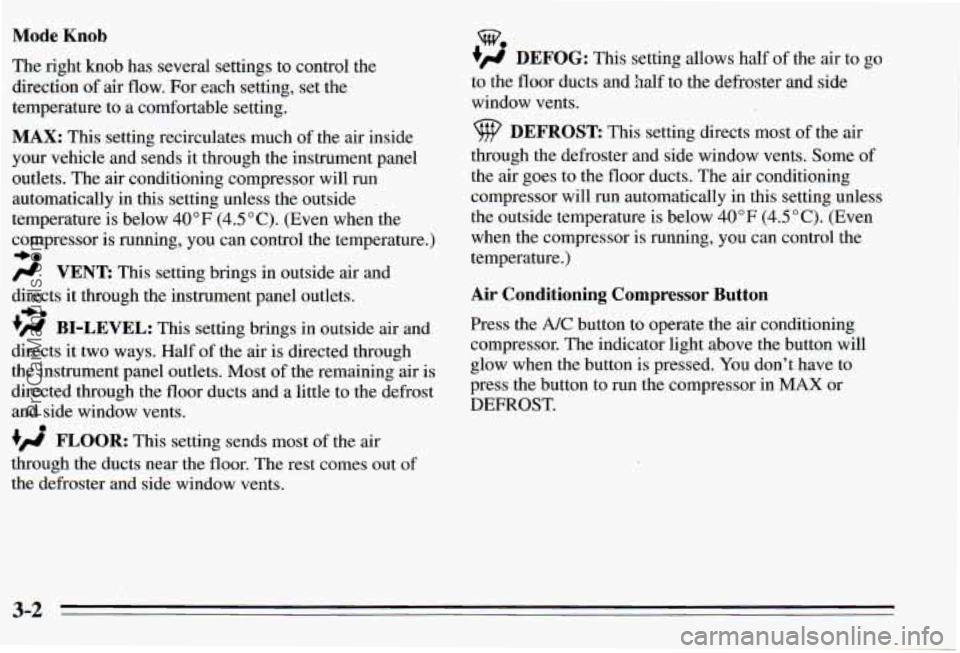
Mode Knob
The right knob has several settings to control the
direction
of air flow. For each setting, set the
temperature to a comfortable setting.
MAX: This setting recirculates much of the air inside
your vehicle and sends
it through the instrument panel
outlets. The air conditioning compressor will run
automatically in this setting unless the outside
temperature is below 40°F (4.5"C). (Even when the
compressor
is running, you can control the temperature.)
-be
/.I VENT This setting brings in outside air and
directs it through the instrument panel outlets.
+' BI-LEVEL: This setting brings in outside air and
directs it two ways. Half of the air is directed through
the instrument panel outlets. Most of the remaining air is
directed through the floor ducts and
a little to the defrost
and side window vents.
FLOOR: This setting sends most of the air
through the ducts near the floor. The rest comes out
of
the defroster and side window vents.
+e
%
+)d DEFOG: This setting allows half of the air to go
to the floor ducts and
half to the defroster and side
window vents.
9 DEFROST: This setting directs most of the air
through the defroster and side window vents. Some of
the air goes to the floor ducts. The air conditioning
compressor will run automatically in this setting unless
the outside temperature
is below 40°F (4.5"C). (Even
when the compressor is running, you can control the
temperature.)
Air Conditioning Compressor Button
Press the A/C button to operate the air conditioning
compressor. The indicator light above the button will
glow when the button is pressed.
You don't have to
press the button to run the compressor in
MAX or
DEFROST.
3-2
ProCarManuals.com
Page 128 of 354

Air Conditioning Heating
On very hot days, open the
windows long enough to
let hot inside air escape. This reduces the time the
compressor has
to run, which should help fuel economy.
For quick cool-down on very hot days,
use MAX with
the temperature knob all the way in the blue area.
If this
setting is used for long periods
of time, the air in your
vehicle may become too dry.
For normal cooling on hot days, use
VENT with the
temperature hob in the blue area and the
A/C button
pushed
in. The system will bring in outside air and cool it.
On cool but sunny days, the sun may warm your upper
body, but your lower body may not be warm enough.
You can use BI-LEVEL with the temperature knob in
the middle and the
A/C button pushed in. The system
will bring in outside air and direct it to your upper body,
while sending slightly warmed air to your lower body.
You may notice this temperature difference more at
some times than others. On
cold days use
FLOOR with the temperature knob all
the way in the red area. The system will bring in outside
air, heat
it and send it to the floor ducts.
If your vehicle has an engine coolant heater, you can use
it to help your system provide warm
air faster when it’s
cold outside (0°F (-lS0C) or lower).
An engine coolant
heater warms the coolant your engine and heating
system use to provide heat. See “Engine Coolant
Heater” in the Index.
Ventilation
For mild outside temperatures when little heating or
cooling is needed, use VENT
to direct outside air
through your vehicle. Your vehicle also has the
flow-through ventilation system described later in this
section.
Defogging and Defrosting Windows
Your system has two settings for clearing the front and
side windows. To defrost the windows quickly, use
DEFROST with the temperature knob all the way in the
red area. To warm passengers while keeping the
windows clean, use DEFOG.
3-3
ProCarManuals.com
Page 129 of 354
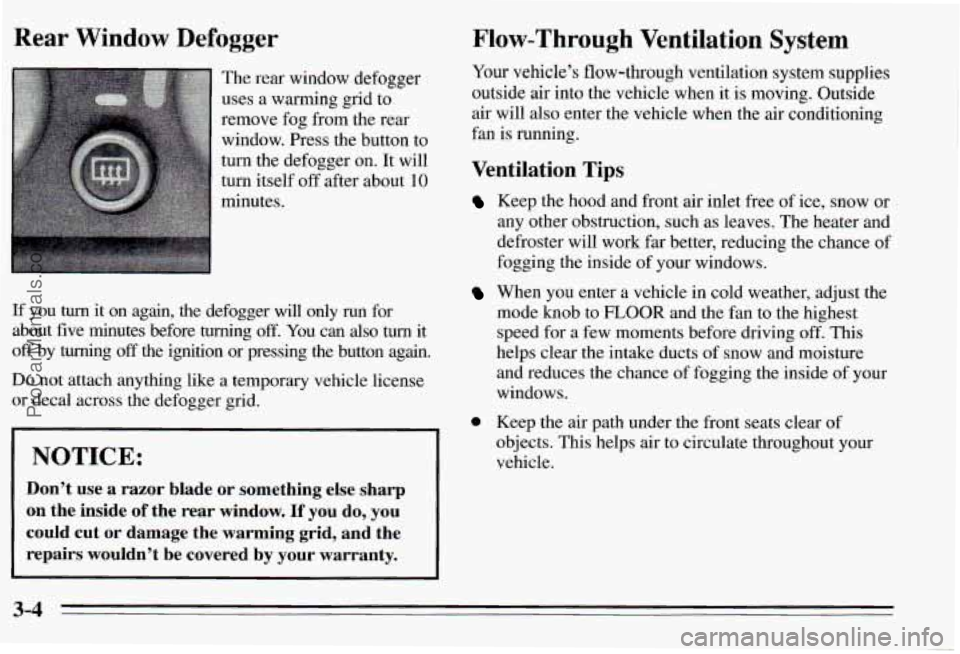
Rear Window Defogger
The rear window defogger
uses a warming grid to
remove fog from the rear
window. Press the button to
turn the defogger on. It will
turn itself off after about 10
minutes.
If you turn it on again, the defogger will only run for
about five minutes before turning
off. You can also turn it
off by turning off the ignition or pressing the button again.
Flow-Through Ventilation System
Your vehicle’s flow-through ventilation system supplies
outside air into the vehicle when it
is moving. Outside
air
will also enter the vehicle when the air conditioning
fan is running.
Ventilation Tips
Do not attach anything like a temporary vehicle license
or decal across the defogger grid.
0
NOTICE:
Don’t use a razor blade or something else sharp
on the inside
of the rear window. If you do, you
could cut or damage the warming grid, and the
repairs wouldn’t be covered by your warranty.
Keep the hood and front air inlet free of ice, snow or
any other obstruction, such as leaves. The heater and
defroster will work
far better, reducing the chance of
fogging the inside of your windows.
When you enter a vehicle in cold weather, adjust the
mode knob to
FLOOR and the fan to the highest
speed for a few moments before driving off.
This
helps clear the intake ducts of snow and moisture
and reduces the chance of fogging the inside of your
windows.
Keep the air path under the front seats clear of
objects. This helps
air to circulate throughout your
vehicle.
3-4
ProCarManuals.com
Page 283 of 354
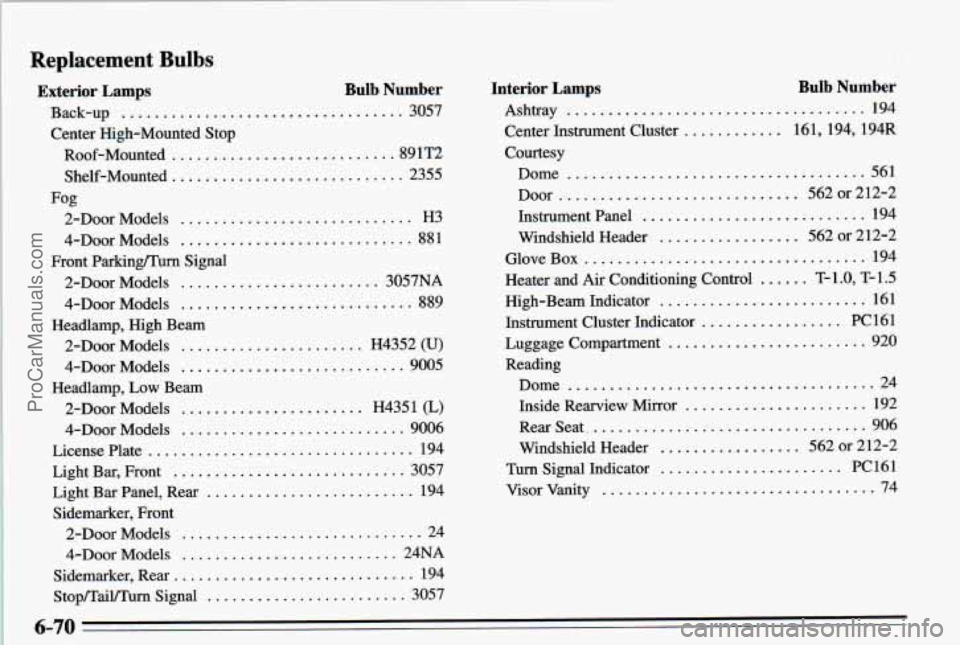
Replacement Bulbs
Exterior.Lamps Bulb- Number
Back-up .................................. 3057
Roof-Mounted
........................... 891T2
Shelf-Mounted
............................ 2355
2-Door Models
............................ H3
4-Door Models ............................ 881
2-Door Models
........................ 3057NA
4-Door Models
............................ 889
2-Door Models
...................... H4352 (U)
4-Door Models ........................... 9005
2-Door Models ...................... H435 1 (L)
4-DaorModels 9006
License Plate
................................ 194
LightBar. Front
............................ 3057
Light
Bar Panel. Rear ......................... 194
Sidemaker. Front
2-Door Models
............................. 24
4-Daor Models
.......................... 24NA
Sidemmker. Rear
............................. 194
Stop/'I'aW'hrn Signal ........................ 3057
Center High-Mounted
Stop
Fag Front Parking/Turn Signal
I Headlamp, High Beam
Headlamp. Low Beam
...........................
I
6-70 ~-
Interior Lamps Bulb Number
Ashtray .................................... 194
Center Instrument Cluster
............ 161. 194. 194R
Courtesy Dome
.................................... 561
Door
............................. 562or212-2
Instrument Panel
........................... 194
Windshield Header
................. 562 or 212-2
GloveBox
.................................. 194
Heater and Air Conditioning Control
...... T- 11.5 .O. T-
Instrument Cluster Indicator ................. PC 161
High-Beam Indicator
......................... 161
Luggage Compartment
........................ 920
Reading Dome
..................................... 24
Inside Rearview Mirror
...................... 192
RearSeat
.................................. 906
Windshield Header
.................. 562 or 212-2
Turn Signal Indicator ...................... PC161
Visor Vanity
................................. 74
ProCarManuals.com
Page 284 of 354
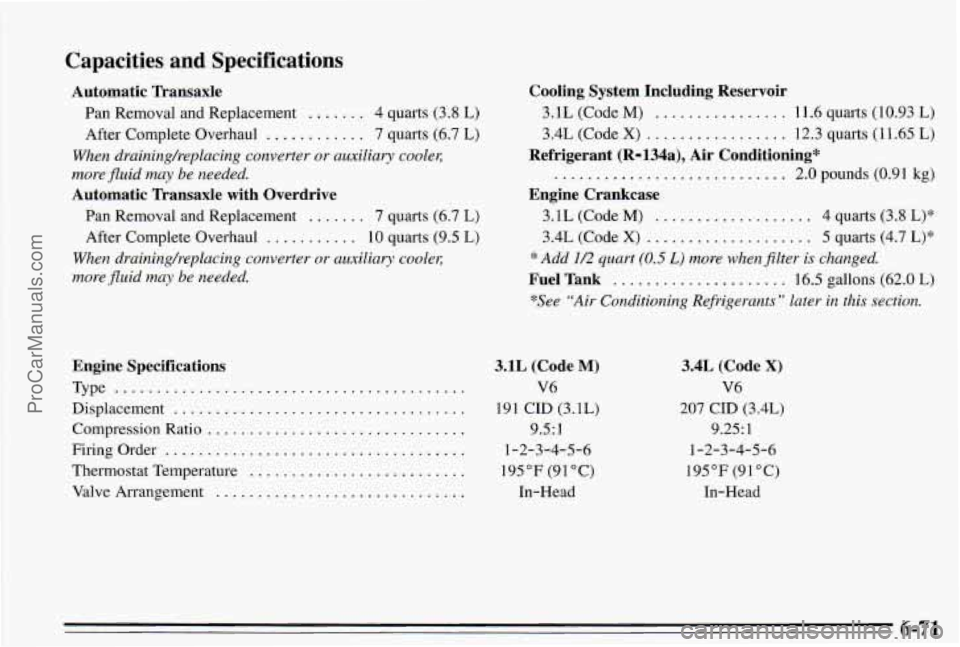
Capacities and Specifications
Automatic Transaxle
Pan Removal and Replacement ....... 4 quarts (3.8 L)
After Complete Overhaul
............ 7 quarts (6.7 L)
When drainingheplacing converter or auxiliary cooleq
more fluid may be needed.
Automatic Tkansaxle with Overdrive
Pan Removal and Replacement ....... 7 quarts (6.7 L)
After Complete Overhaul
........... 10 quarts (9.5 L)
When drainingheplacing converter or auxiliary cooler,
more fluid may be needed.
Engine Specifications
Displacement ...................................
Compression Ratio ...............................
Thermostat Temperature ..........................
Type ..........................................
Firingorder ....................................
ValveArrangement ..............................
Cooling System Including Reservoir
3.1L (Code M) ................ 11.6 quarts (10.93 L)
3.4L (Code
X) ................. 12.3 quarts (1 1.65 L)
............................ 2.0 pounds (0.91 kg)
3.1L (Code M) ................... 4 quarts (3.8 L)*
3.4L (Code
X) .................... 5 quarts (4.7 L)*
*Add 1/2 quurt (0.5 L) more when filter is changed.
Fuel Tank ..................... 16.5 gallons (62.0 L)
*See "Air Conditioning Refrigerants '' later in this section.
Refrigerant (R-l34a), Air Conditioning"
Engine Crankcase
3.1L (Code
M)
V6
191 CID (3.1L) 9.5:
1
1-2-3-4-5-6
195°F (91 "C)
In-Head
3.4L (Code X)
V6
207 CID (3.4L) 9.25:
1
1-2-3-4-5-6
195°F (91°C)
In-Head
6-71 ProCarManuals.com
Page 285 of 354

Normal Maintenance Replacement Parts
Air Cleaner Filter
Battery
All Engines ............................. A1208C
3.1L (Code
M) ......................... 525 CCA
3.4L (Code
M) ......................... 690 CCA
3.1L (Code
M) ............................. PF47
3.4L (Code
X) .............................. PF5 1
3.1L (Code M)
.......................... CV892C
3.4L (Code
X) ........................... CV895C
All Engines
............................... RC27
3.1L (Code
M) ....................... oR44LTSM6
3.4L
(Code X) ......................... oR42LTSM
Engine Oil Filter
PCV
Valve
Radiator Cap
Spark Plugs
Gap: 0.060” (1 52 mm)
Gap: 0.045” (1.14 mm) I
Air Conditioning Refrigerants
Not all air conditioning refrigerants are the same. If
the air conditioning system in your vehicle needs
refrigerant, be sure the proper refrigerant is used.
If
you’re not sure, ask your Pontiac dealer. For additional
information, see your “Warranty and Owner1 Assistance
Information” booklet.
ProCarManuals.com